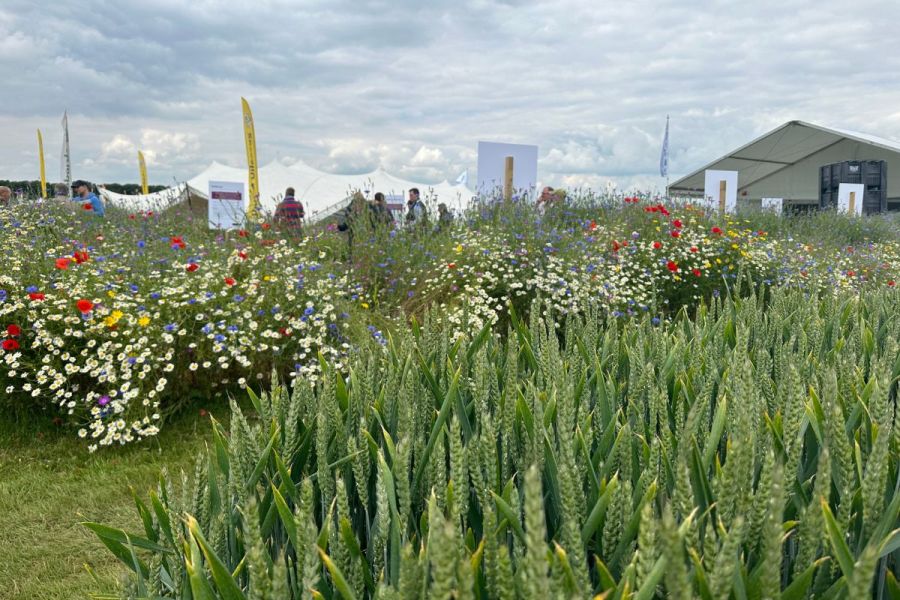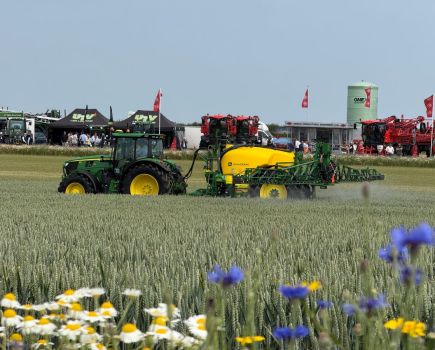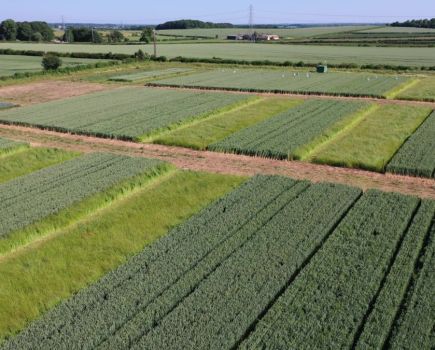Farming has faced an incredibly trying season, but this year’s Cereals Event proved there’s still plenty to be positive and optimistic about, whether it’s a change in the administration, progressive breeding or the wider adoption of precision technologies. CPM reports.
“The words ‘food security is national security’ have been used by all political parties, but words don’t keep people fed.”
By Melanie Jenkins
The sentiment at this year’s Cereals Event, held at Bygrave Woods in Hertfordshire last month, was very much one focused on the impending general election (although by the time CPM lands on doorsteps, this will have been decided).
Opening speaker, NFU chairman, Tom Bradshaw, noted that although the public purse is under huge stress, it’s vital the incoming government values the importance of investing in the future of farming.
Currently, £2.4Bn is committed to support farming – a figure that’s been consistent since 2005. But compared with today’s value, it’s only worth about one third of that in real term value, highlighted Tom.
“UK farming requires £5.5Bn, a figured that’s been determined by Andersons, and I understand that the public purse is under pressure, but we have to decide what we prioritise and how much we want to deliver the twin ambitions of sustainable food production alongside environmental delivery. If we purely focus on the environment, then we’ll fail on food production.
“The words ‘food security is national security’ have been used by all political parties, but words don’t keep people fed. If we’re serious about food production, we have to underpin this with policy.”
Tom flagged that the roll out of the Sustainable Farming Incentive has been very welcome, but asked where the priorities of government lie. “Where does food production fit into this? You can’t take the amount of land out of food production which will be removed by SFI, and expect there to still be the same amount of food produced. One of our key asks of the new government will be to publish impact assessments for policy that’s being developed, the expectations they have, the viability for farm businesses and the impact on food production.”
Taking responsibility will be essential for any policy, added Tom. “If we do end up with a government that takes an ‘out of sight, out of mind’ attitude towards imports, and which is happy to use other resources from around the world to feed the UK population, then we’re going to have a huge challenge.
“Our import standards have to reinforce our domestic ones – it’s not about protectionism, it’s about fair trade rather than free trade. If we’re serious about solving the world’s problems, we can’t simply offshore our production to other parts of the world.
“With 70M people living on our island, I think this gives farming an opportunity to feed them with high quality British ingredients. Imports will always be part of food security but having a strategy for domestic food production as a critical part of resilience of feeding these people should be a priority for government.”
Tom is keen to see the new administration properly roll out the Farming Recovery Fund so that it encapsulates as many farmers as possible, but he fears it could be viewed as the previous government’s plan. “The extra £49M was welcome and we hope the new administration will see the fund as depoliticised.”
But on a more positive note, the NFU launched its latest #YourHarvest social media campaign on the first day of the show to highlight the challenges faced on arable farms after 12 months of difficult weather conditions, explained NFU combinable crops board vice-chairman, James Mills. “The campaign is so important because we have to emphasise the challenges on farm but also look forward to work in partnership with government to tackle the volatility and ensure there’s resilience in the sector.”
But whatever the industry sees in terms of agricultural policy under the incoming government, tactical grain marketing remains as important as ever, as was highlighted during a seminar exploring global grain markets and UK prices.
Looking at the oilseed rape market, the current situation may see the UK crop at an 80-year low of 800,000t, said United Oilseeds’ Owen Clegg. “The UK demand is 2M tonnes, and although prices have fallen from the recent highs of £400/t, they’re still at £370-£375/t ex-farm at present.”
There’s also likely to be a deficit in supply comparative with demand in Europe, with production estimated at 18M tonnes, whereas crush demand sits at round 25-27M tonnes, he explained. “This has resulted in an interesting scenario, with one of the main import/export destinations is Ukraine which has quite a few logistical issues and growers that tend to be price takers.
“The other major producer is Canada which can produce up to 20M tonnes,” he said. “But Canadian OSR has been trading at a premium to other markets and there’s a lot of demand for Canadian canola oil in the US for biodiesel.”
But when it comes to cereals the anticipated difficulties of moving exports out of Ukraine have proven far less of an issue than expected, said James Bolesworth of CRM AgriCommodities. What growers have to consider is the influence that higher interest rates will have on the market. “From the perspective of investors, they’re far more likely to invest when rates are lower than they are now. We anticipate rates might fall from September, but this could change and make it less attractive for investors to buy commodities, so should be considered.”
In terms of fundamentals, James flagged that 25% of global wheat production originates in Russia. “Russia has declared a crop emergency in 10 different regions with production down from 100M tonnes to 80M tonnes, which even the grain fill period is unlikely to help this recover. And in Turkey, exports have been banned for the next four months.”
Looking at stocks relative to demand, supply is continuing to fall, he said. “The ratio is the tightest we’ve seen going back to 2008, but there’ll be a limited ability for prices to rally because of interest rates.”
However, he advised growers to watch for shifts in weather patterns as the El Niño phenomenon shifts to La Niña as this will play a key factor going forward.
The milling wheat situation has been no less tumultuous with Cefetra’s Chris Wood describing the past couple of years as ‘crazy’. “Our overall domestic wheat demand is around 14M tonnes, so there’ll be a deficit this year.”
But what about risk management? “There’s a lot more volatility in our markets and it’s important to emphasise that operating in any market is incredibly difficult – traders and analysts are wrong all the time,” he acknowledged. “So understand your business and what you’re likely to achieve from a marketing perspective, know your tolerance to risk, and be aware that you can make the right decisions but still be wrong in the market.
“Spread your risk by using a trading company, get a professional voice, use a harvest pool or trackers which sell when prices are X-% above cost of production,” he added. “Just tailor your risk management to meet your business and aim for a solid price because trying to outperform the market is hard.”
If outperforming the market is so difficult, could growers consider other options such as green premiums? According to Richardson Milling’s Brin Hughes, food brands are increasingly asking for the origins of the oats they buy, whether they’re low carbon or not, what the greenhouse gas emissions are, and if they’ve been grown regeneratively.
“It’s long been known that intensive agriculture is linked to biodiversity loss so there’s awareness among brands of this and they want farmers to transition to be more sustainable.”
But does this pay for farmers? Brin noted that firms such as Huel and PepsiCo (which owns brands including Jordans and Ryvita) are paying a premium for oats with the LEAF accreditation, and Richardson itself is working with Cefetra to establish a carbon payment for farmers.
It’s not just food brands which are pushing for greener production but the wider supply chain. Charles Tozer, general manager of Boortmalt and chairman of the Maltsters Association of Great Britan, said the industry wants to see significant and sustained improvements in energy and water consumption within the sector.
“We’ve our own sustainability strategy as a sector that can collaboratively improve the carbon footprint and environmental credentials of producing malt, something customers and consumers are demanding from us. We’ve recently signed a deal with Cefetra to buy reduced carbon malting barley and are looking at all our suppliers to see what can be done to reduce the carbon footprint.”
For Simon Penson of ADM Milling, the key focus for reducing carbon emissions in the supply chain is at source. “About 90% of our carbon emissions come from the wheat we purchase because although flour milling is an energy intensive industry, most of the supply is from renewable sources which is why sustainable agriculture is so important to UK flour millers.
“We’re working with major food businesses such as PepsiCo and Carlsberg, and have launched a programme to work with a group of farmers to help them introduce regenerative practices and make sure we have sustainable wheat growing systems for the future.”
But what about crop breeding, and is there potential in this increasingly vital tool to produce varieties suited to more sustainable and regenerative practices? BSPB’s Anthony Hopkins highlighted the organisation wants farmers to have access to the best varieties to fit their systems so they can grow profitable crops, but the industry is currently facing multiple challenges.
“Fundamentally, the challenges are down to Brexit and how the government has reacted to it, specifically in terms of trade barriers. Seed breeding is a global business and anything this country does to make it harder to move seed around makes it more difficult for anyone wanting to grow crops,” he explained.
Prior to Brexit, varieties could be listed anywhere in Europe and be grown in the UK, but now have to be nationally listed here. “UK growers now get varieties later than those in Europe and because the market in the UK is smaller, breeders don’t always see the cost of bringing varieties here as being worth it.”
Despite these challenges, breeders such as KWS have made headway in producing varieties better able to withstand difficult growing conditions. “One of the main areas of progress we’ve made is in untreated yields,” explained the firm’s Henry Barber. “In 2003, 26% of the varieties on AHDB’s Recommended List had untreated yields of about 80%, but as of 2024 it’s 76% of varieties.”
A further area of focus has been grain quality and how to achieve protein while maintaining yield. “Trying to balance the two has been more challenging for breeders and we get asked if there’s enough genetic diversity out there.”
Arguably an area of both concern and curiosity, genetic diversity can divide opinions but independent wheat breeder, Bill Angus, highlights there are already multiple germplasm in the varieties being grown. “Breeders produce millions of combinations a year and there are introgressions that are basically wider crossed which have been a route forward to higher yields. We aren’t short of genetic variation, there’s plenty out there, for example, orange wheat blossom midge resistance came from a Russian variety.
“What we do have to do is rebalance the equation between breeding and chemistry, because if we took the chemicals away then we’d see yield reductions of 25-30% in wheat alone.”
To overcome the challenges breeders face in producing more resilient varieties, Bill would like to see more high quality and diverse trials. “I don’t think this requires more investment, just better use of it. There also has to be less regulation and greater flexibility because we’re currently struggling to introduce forage oats to the UK because there’s no system in place to allow them.
“And yet forage oats are a low-cost environmentally friendly opportunity for UK growers, something that’ll benefit them and avoid the high cost of hybrid crops.”
Advances in breeding offer greater options every year and there are opportunities to be seized with Elsoms’ George Goodwin flagging that varieties such as Blackstone provide growers with the option of growing a feed wheat that could also go into distilling or for export.
“A soft Group 4 wheat, it has one of the most flexible sowing windows from 1 September but is also an option if you have late lifted sugar beet and want something that’ll go in from the end of October into December, with even the option of January/February drilling.”
Achieving 103% for its treated yield on the RL, Blackstone scores 9 against yellow rust, 6.2 for septoria and 6 against brown rust. “It offers lots of agronomic benefits and growth-wise it’s steady paced in autumn and picks up later on, allowing growers to keep on top of their spray programmes.”
Looking to provide barley growers with increasing opportunities, KWS has launched its first hybrid, Inys. Achieving 109% of control, it scores 7 for mildew and 6 for brown rust, rhynchosporium and net blotch, explained the firm’s Kate Cobbold. “In both of Inys’ National List testing years we haven’t seen any occurrences of lodging and it has a key attribute of lower brackling than other varieties on the RL.”
It’s not just plant breeding that is helping to drive the green revolution in agriculture, but almost as a juxtaposition, so is machinery. Yet investing in technology with benefits such as improved precision can be expensive and it can be difficult to quantify the environmental benefits.
Speaking at Cereals, Stephen Howarth of the Agricultural Engineers Association, said a US study conducted recently evaluated the potential benefits of precision technology, auto guidance/GPS, section control, variable rate applications and machine/fleet analytics.
He detailed that technology was shown to benefit farmers in four main ways: through productivity, improved soil health, better water and air quality, plus through emissions savings.
During the study, benefits were split into those already seen and what could be possible if uptake increased to ‘optimal’ levels, he said. “Up until now, there’s been about a 4% yield increase from the use of precision technology and this could rise another 6% in an optimal scenario. If we could achieve this in cereals and OSR yields in the UK, we would see an increase in production of 1.5M tonnes on the same area of land that’s currently used. Or output could remain the same while we released 200,000ha of land for other uses.
“But the uptake of precision technology in the UK is around 35-45%, whereas in the US it’s more like 50-60%, with people not adopting it because they see it at too expensive or not relevant,” added Stephen.
New Holland’s Nigel Honeyman observed that precision technology is also no longer about the single implement or machine, but about compatible and connected farming. “In precision farming, everything has to link up to make it future-proof and sustainable. We’re no longer talking about pieces of hardware on their own but a whole ecosystem of products surrounding it which are all related.”
And while he noted there are now numerous ways to collect useful and informative data, it’s of no use by itself. “For data to serve any purpose you have to be able to action it, otherwise it’s worthless and you might as well not collect it. And we’ve often been lackadaisical about how we use and store data on farm, but if you lose it then you’re back to the basics again.”
Further to this, he flagged the value of understanding the data and knowing when, where and how it will be useful. “For example, grain quality analysis doesn’t work for everyone. For those chasing quality premiums it has value, but for those just after yield, it might not be relevant to you.”
Amazone’s Simon Brown, who’s retiring from his post as managing director this year, is as enthusiastic and optimistic for the future of agriculture as ever. He pointed out that a lot of precision technology is now established but the next push is to achieve plant-by-plant application to drive down environmental impacts, reduce costs and improve time efficiency.
He also observed how quickly this technology is improving, highlighting that in 2007, fertiliser spreaders had six section control, but this is now at over 100 sections. “With 128 section shut off on a spreader, there’s a 10% saving in fertiliser use compared with manual shut off which is a vast amount of money saved which can then be reinvested.”
But it’s not just technology to reduce inputs that has an environmental benefit, spreaders can be fitted with radar to watch spread patterns and monitor any changes to bring the application back to being accurate, he explained. “Machines can also check changing wind speed and direction and make alterations accordingly – it’s all about putting inputs exactly where they’re required.”
Simon feels that farm machinery will change more in the next five years than it has in the past 25. “Autonomous vehicles bring so much more potential to farming, where output is achieved through efficiency not width. But we have to be allowed to remotely spray and remotely refuel to achieve this.”
This article was taken from the latest issue of CPM. Read the article in full here.
For more articles like this, subscribe here.
Sign up for Crop Production Magazine’s FREE e-newsletter here.




